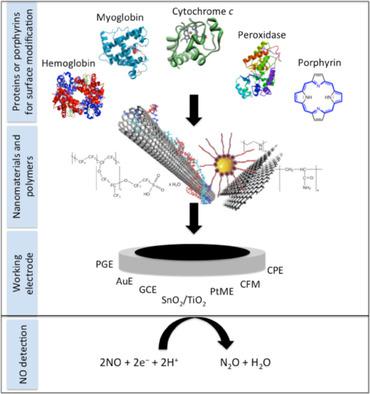当前位置:
X-MOL 学术
›
Electroanalysis
›
论文详情
Our official English website, www.x-mol.net, welcomes your feedback! (Note: you will need to create a separate account there.)
Nitric Oxide Detection Using Electrochemical Third-generation Biosensors - Based on Heme Proteins and Porphyrins
Electroanalysis ( IF 3 ) Pub Date : 2018-08-22 , DOI: 10.1002/elan.201800421 Filipa O. Gomes 1, 2 , Luísa B. Maia 2 , Cristina Cordas 2 , Cristina Delerue-Matos 1 , Isabel Moura 2 , José J. G. Moura 2 , Simone Morais 1
Electroanalysis ( IF 3 ) Pub Date : 2018-08-22 , DOI: 10.1002/elan.201800421 Filipa O. Gomes 1, 2 , Luísa B. Maia 2 , Cristina Cordas 2 , Cristina Delerue-Matos 1 , Isabel Moura 2 , José J. G. Moura 2 , Simone Morais 1
Affiliation

|
Nitric oxide radical (NO) is a signalling molecule involved in virtually all forms of life. Its relevance has been leading to the development of different analytical methodologies to assess the temporal and spatial fluxes of NO under the complex biological milieu. Third-generation electrochemical biosensors are promising tools for in loco and in vivo NO quantification and, over the past years, heme proteins and porphyrins have been used in their design. Since there are some limitations with the biorecognition element directly adsorbed onto the electrode surface, nanomaterials (carbon nanotubes, gold nanoparticles, etc.) and polymers (cellulose, chitosan, nafion , polyacrylamide, among others) have been explored to achieve high kinetics and better biosensor performance. In this review, a broad overview of the field of electrochemical third-generation biosensors for NO electroanalysis is presented, discussing their main characteristics and aiming new outlooks and advances in this field.
中文翻译:

使用电化学第三代生物传感器检测一氧化氮 - 基于血红素蛋白和卟啉
一氧化氮自由基 (NO) 是一种信号分子,几乎涉及所有生命形式。它的相关性导致了不同分析方法的发展,以评估复杂生物环境下 NO 的时空通量。第三代电化学生物传感器是用于体内和体内 NO 定量的有前途的工具,并且在过去几年中,血红素蛋白和卟啉已被用于其设计中。由于直接吸附在电极表面的生物识别元件存在一些局限性,因此已经探索了纳米材料(碳纳米管、金纳米粒子等)和聚合物(纤维素、壳聚糖、nafion、聚丙烯酰胺等)以实现高动力学和更好的识别。生物传感器性能 在这次审查中,
更新日期:2018-08-22
中文翻译:

使用电化学第三代生物传感器检测一氧化氮 - 基于血红素蛋白和卟啉
一氧化氮自由基 (NO) 是一种信号分子,几乎涉及所有生命形式。它的相关性导致了不同分析方法的发展,以评估复杂生物环境下 NO 的时空通量。第三代电化学生物传感器是用于体内和体内 NO 定量的有前途的工具,并且在过去几年中,血红素蛋白和卟啉已被用于其设计中。由于直接吸附在电极表面的生物识别元件存在一些局限性,因此已经探索了纳米材料(碳纳米管、金纳米粒子等)和聚合物(纤维素、壳聚糖、nafion、聚丙烯酰胺等)以实现高动力学和更好的识别。生物传感器性能 在这次审查中,



























 京公网安备 11010802027423号
京公网安备 11010802027423号